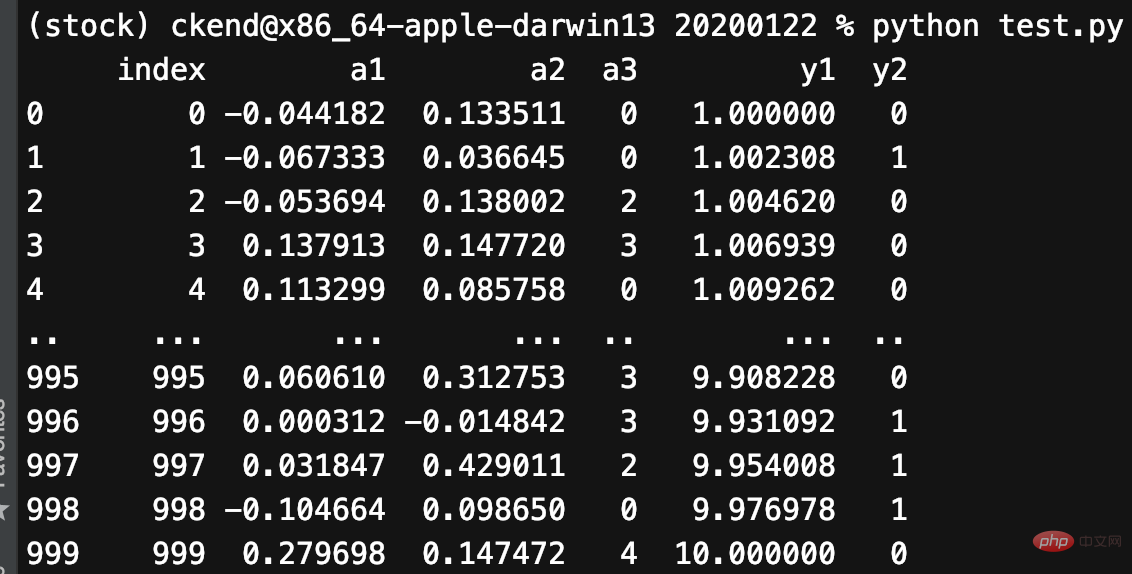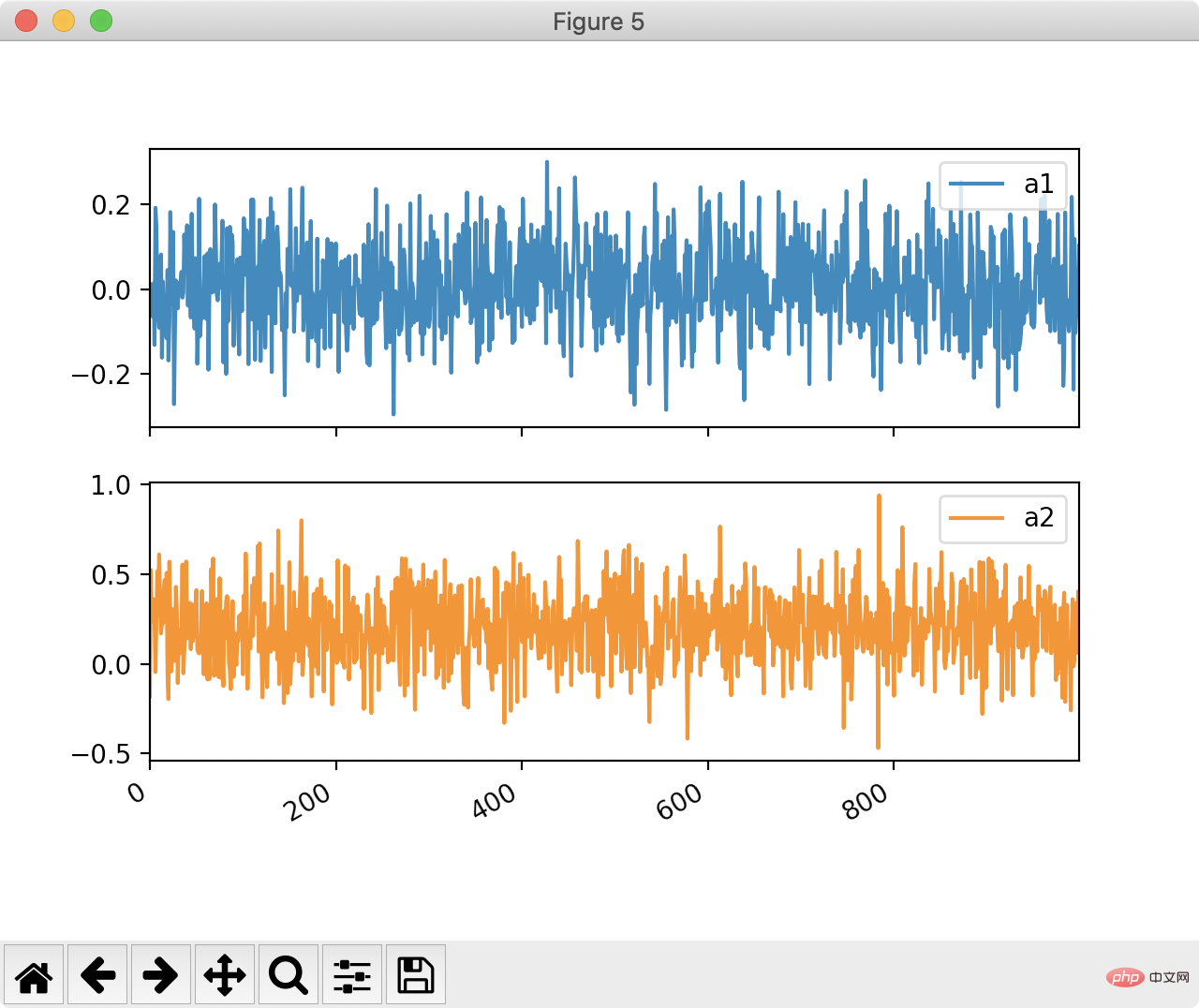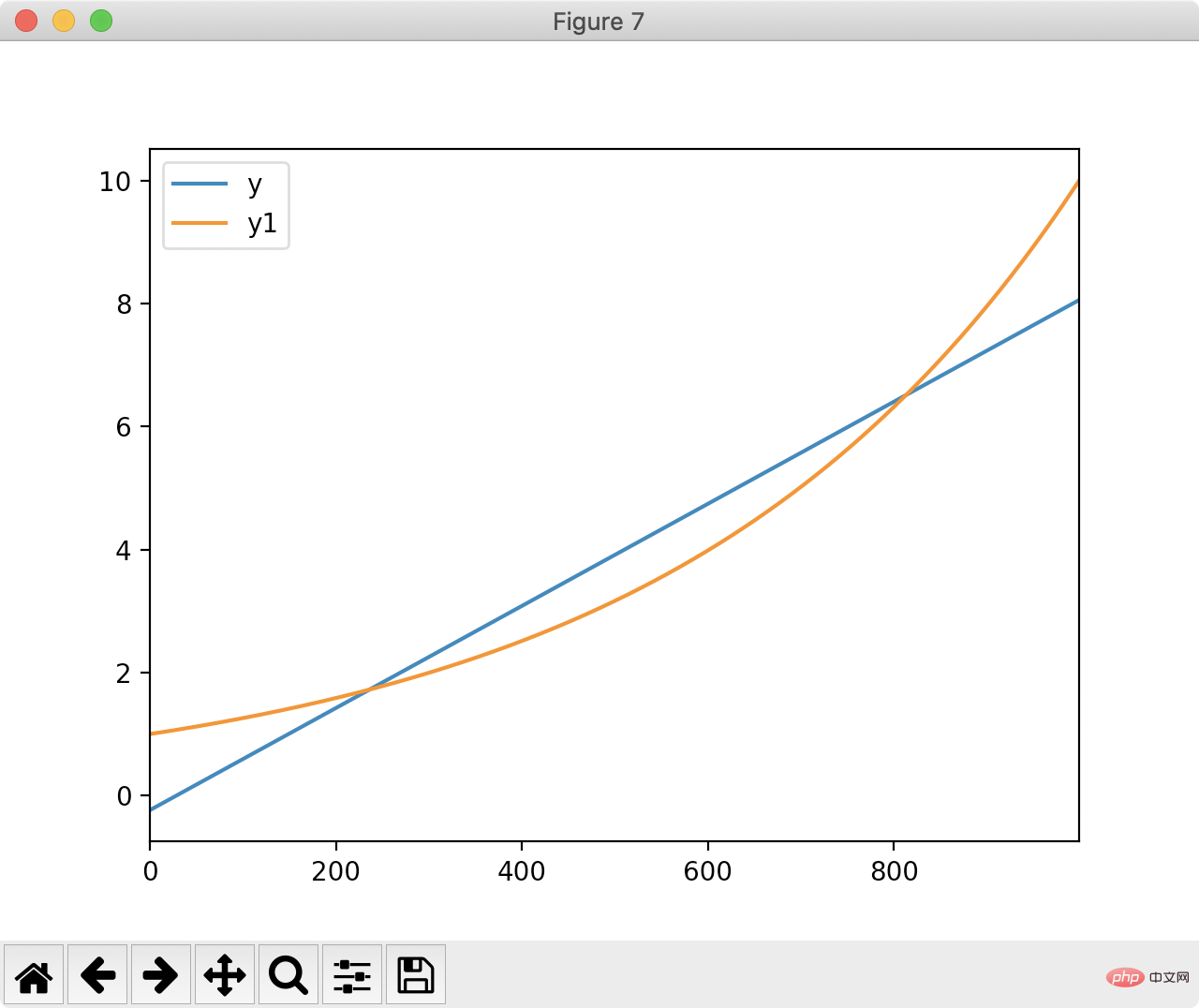살펴볼 가치가 있는 Python의 효율적인 데이터 처리

Pandas는 Python에서 매우 일반적으로 사용되는 데이터 처리 도구이며 사용하기 매우 편리합니다. NumPy 배열 구조를 기반으로 구축되었으므로 많은 작업이 NumPy 또는 Pandas와 함께 제공되는 확장 모듈을 통해 작성됩니다. 이러한 모듈은 Cython으로 작성되고 C로 컴파일되며 C에서 실행되므로 처리 속도가 보장됩니다. 오늘 우리는 그 힘을 경험해보겠습니다.
1. 데이터 생성pandas를 사용하면 쉽게 데이터를 생성할 수 있습니다. 이제 5개의 열과 1000개의 행이 있는 pandas DataFrame을 만들어 보겠습니다. mu1, sigma1 = 0, 0.1
mu2, sigma2 = 0.2, 0.2
n = 1000df = pd.DataFrame(
{
"a1": pd.np.random.normal(mu1, sigma1, n),
"a2": pd.np.random.normal(mu2, sigma2, n),
"a3": pd.np.random.randint(0, 5, n),
"y1": pd.np.logspace(0, 1, num=n),
"y2": pd.np.random.randint(0, 2, n),
}
)로그인 후 복사
a1 및 a2: 무작위 샘플의 정규(가우스) 분포에서 추출됩니다. . a3: 0에서 4 사이의 임의의 정수. mu1, sigma1 = 0, 0.1
mu2, sigma2 = 0.2, 0.2
n = 1000df = pd.DataFrame(
{
"a1": pd.np.random.normal(mu1, sigma1, n),
"a2": pd.np.random.normal(mu2, sigma2, n),
"a3": pd.np.random.randint(0, 5, n),
"y1": pd.np.logspace(0, 1, num=n),
"y2": pd.np.random.randint(0, 2, n),
}
)- y1: 0에서 1까지의 로그 척도로 균일하게 분포됩니다.
- y2: 0에서 1 사이의 임의의 정수.
- 아래와 같이 데이터를 생성합니다.
2. 이미지 그리기 
Pandas 그리기 함수는 matplotlib 좌표축(Axes)을 반환하므로 그 위에 그리는 데 필요한 것을 사용자 정의할 수 있습니다. 예를 들어 수직선과 평행선을 그립니다. 이는 우리에게 매우 도움이 될 것입니다:
1. 평균 선 그리기2. 핵심 사항 표시
import matplotlib.pyplot as plt ax = df.y1.plot() ax.axhline(6, color="red", linestyle="--") ax.axvline(775, color="red", linestyle="--") plt.show()
또한 하나의 차트에 표시되는 테이블 수를 사용자 정의할 수 있습니다.
fig, ax = plt.subplots(2, 2, figsize=(14,7)) df.plot(x="index", y="y1", ax=ax[0, 0]) df.plot.scatter(x="index", y="y2", ax=ax[0, 1]) df.plot.scatter(x="index", y="a3", ax=ax[1, 0]) df.plot(x="index", y="a1", ax=ax[1, 1]) plt.show()

3. 히스토그램 그리기 
Pandas를 사용하면 매우 간단한 방법으로 두 그래픽의 모양을 비교할 수 있습니다. df[["a1", "a2"]].plot(bins=30, kind="hist")
plt.show()
로그인 후 복사
또한 여러 그래픽을 그릴 수도 있습니다.
df[["a1", "a2"]].plot(bins=30, kind="hist") plt.show()
df[["a1", "a2"]].plot(bins=30, kind="hist", subplots=True) plt.show()
 물론 선 차트 생성은 더 이상 그려지지 않습니다.
물론 선 차트 생성은 더 이상 그려지지 않습니다.
df[['a1', 'a2']].plot(by=df.y2, subplots=True) plt.show()

4. 선형 피팅
팬더를 사용하여 다음 그림에 가장 가까운 직선을 찾을 수도 있습니다.
최소 제곱법은 직선으로부터 최단 거리를 계산합니다.df['ones'] = pd.np.ones(len(df)) m, c = pd.np.linalg.lstsq(df[['index', 'ones']], df['y1'], rcond=None)[0]
df['y'] = df['index'].apply(lambda x: x * m + c) df[['y', 'y1']].plot() plt.show()
 읽어주셔서 감사합니다. 많은. 이 기사는 https://blog.csdn.net/u010751000/article/details/106735872
읽어주셔서 감사합니다. 많은. 이 기사는 https://blog.csdn.net/u010751000/article/details/106735872
위 내용은 살펴볼 가치가 있는 Python의 효율적인 데이터 처리의 상세 내용입니다. 자세한 내용은 PHP 중국어 웹사이트의 기타 관련 기사를 참조하세요!

핫 AI 도구

Undresser.AI Undress
사실적인 누드 사진을 만들기 위한 AI 기반 앱

AI Clothes Remover
사진에서 옷을 제거하는 온라인 AI 도구입니다.

Undress AI Tool
무료로 이미지를 벗다

Clothoff.io
AI 옷 제거제

AI Hentai Generator
AI Hentai를 무료로 생성하십시오.

인기 기사

뜨거운 도구

메모장++7.3.1
사용하기 쉬운 무료 코드 편집기

SublimeText3 중국어 버전
중국어 버전, 사용하기 매우 쉽습니다.

스튜디오 13.0.1 보내기
강력한 PHP 통합 개발 환경

드림위버 CS6
시각적 웹 개발 도구

SublimeText3 Mac 버전
신 수준의 코드 편집 소프트웨어(SublimeText3)

뜨거운 주제
 7441
7441
 15
15
 1370
1370
 52
52
 76
76
 11
11
 32
32
 19
19
 C 언어 합계의 기능은 무엇입니까?
Apr 03, 2025 pm 02:21 PM
C 언어 합계의 기능은 무엇입니까?
Apr 03, 2025 pm 02:21 PM
C 언어에는 내장 합계 기능이 없으므로 직접 작성해야합니다. 합계는 배열 및 축적 요소를 가로 질러 달성 할 수 있습니다. 루프 버전 : 루프 및 배열 길이를 사용하여 계산됩니다. 포인터 버전 : 포인터를 사용하여 배열 요소를 가리키며 효율적인 합계는 자체 증가 포인터를 통해 달성됩니다. 동적으로 배열 버전을 할당 : 배열을 동적으로 할당하고 메모리를 직접 관리하여 메모리 누출을 방지하기 위해 할당 된 메모리가 해제되도록합니다.
 누가 더 많은 파이썬이나 자바 스크립트를 지불합니까?
Apr 04, 2025 am 12:09 AM
누가 더 많은 파이썬이나 자바 스크립트를 지불합니까?
Apr 04, 2025 am 12:09 AM
기술 및 산업 요구에 따라 Python 및 JavaScript 개발자에 대한 절대 급여는 없습니다. 1. 파이썬은 데이터 과학 및 기계 학습에서 더 많은 비용을 지불 할 수 있습니다. 2. JavaScript는 프론트 엔드 및 풀 스택 개발에 큰 수요가 있으며 급여도 상당합니다. 3. 영향 요인에는 경험, 지리적 위치, 회사 규모 및 특정 기술이 포함됩니다.
 별개의 구별이 관련되어 있습니까?
Apr 03, 2025 pm 10:30 PM
별개의 구별이 관련되어 있습니까?
Apr 03, 2025 pm 10:30 PM
구별되고 구별되는 것은 구별과 관련이 있지만, 다르게 사용됩니다. 뚜렷한 (형용사)는 사물 자체의 독창성을 묘사하고 사물 사이의 차이를 강조하는 데 사용됩니다. 뚜렷한 (동사)는 구별 행동이나 능력을 나타내며 차별 과정을 설명하는 데 사용됩니다. 프로그래밍에서 구별은 종종 중복 제거 작업과 같은 컬렉션에서 요소의 독창성을 나타내는 데 사용됩니다. 홀수 및 짝수 숫자를 구별하는 것과 같은 알고리즘이나 함수의 설계에 별개가 반영됩니다. 최적화 할 때 별도의 작업은 적절한 알고리즘 및 데이터 구조를 선택해야하며, 고유 한 작업은 논리 효율성의 구별을 최적화하고 명확하고 읽을 수있는 코드 작성에주의를 기울여야합니다.
 이해하는 방법! x는?
Apr 03, 2025 pm 02:33 PM
이해하는 방법! x는?
Apr 03, 2025 pm 02:33 PM
! x 이해! x는 C 언어로 된 논리적 비 운영자입니다. 그것은 x의 값, 즉 실제 변경, 거짓, 잘못된 변경 사항을 부수합니다. 그러나 C의 진실과 거짓은 부울 유형보다는 숫자 값으로 표시되며, 0이 아닌 것은 참으로 간주되며 0만이 거짓으로 간주됩니다. 따라서! x는 음수를 양수와 동일하게 처리하며 사실로 간주됩니다.
 C 언어에서 합계는 무엇을 의미합니까?
Apr 03, 2025 pm 02:36 PM
C 언어에서 합계는 무엇을 의미합니까?
Apr 03, 2025 pm 02:36 PM
합에 대한 C에는 내장 합계 기능이 없지만 다음과 같이 구현할 수 있습니다. 루프를 사용하여 요소를 하나씩 축적합니다. 포인터를 사용하여 요소를 하나씩 액세스하고 축적합니다. 큰 데이터 볼륨의 경우 병렬 계산을 고려하십시오.
 H5 페이지 생산에는 지속적인 유지 보수가 필요합니까?
Apr 05, 2025 pm 11:27 PM
H5 페이지 생산에는 지속적인 유지 보수가 필요합니까?
Apr 05, 2025 pm 11:27 PM
코드 취약점, 브라우저 호환성, 성능 최적화, 보안 업데이트 및 사용자 경험 개선과 같은 요소로 인해 H5 페이지를 지속적으로 유지해야합니다. 효과적인 유지 관리 방법에는 완전한 테스트 시스템 설정, 버전 제어 도구 사용, 페이지 성능을 정기적으로 모니터링하고 사용자 피드백 수집 및 유지 관리 계획을 수립하는 것이 포함됩니다.
 58.com 작업 페이지에서 실시간 응용 프로그램 및 뷰어 데이터를 얻는 방법은 무엇입니까?
Apr 05, 2025 am 08:06 AM
58.com 작업 페이지에서 실시간 응용 프로그램 및 뷰어 데이터를 얻는 방법은 무엇입니까?
Apr 05, 2025 am 08:06 AM
크롤링하는 동안 58.com 작업 페이지의 동적 데이터를 얻는 방법은 무엇입니까? Crawler 도구를 사용하여 58.com의 작업 페이지를 크롤링 할 때는이 문제가 발생할 수 있습니다.
 사랑 코드 복사 및 붙여 넣기 복사하여 사랑 코드를 무료로 붙여 넣으십시오.
Apr 04, 2025 am 06:48 AM
사랑 코드 복사 및 붙여 넣기 복사하여 사랑 코드를 무료로 붙여 넣으십시오.
Apr 04, 2025 am 06:48 AM
코드 복사 및 붙여 넣기는 불가능하지는 않지만주의해서 처리해야합니다. 코드의 환경, 라이브러리, 버전 등과 같은 종속성은 현재 프로젝트와 일치하지 않으므로 오류 또는 예측할 수없는 결과를 초래할 수 있습니다. 파일 경로, 종속 라이브러리 및 Python 버전을 포함하여 컨텍스트가 일관되게 유지하십시오. 또한 특정 라이브러리의 코드를 복사 및 붙여 넣을 때 라이브러리 및 해당 종속성을 설치해야 할 수도 있습니다. 일반적인 오류에는 경로 오류, 버전 충돌 및 일관되지 않은 코드 스타일이 포함됩니다. 성능 최적화는 코드의 원래 목적 및 제약에 따라 재 설계 또는 리팩토링되어야합니다. 복사 코드를 이해하고 디버그하고 맹목적으로 복사하여 붙여 넣지 않는 것이 중요합니다.




